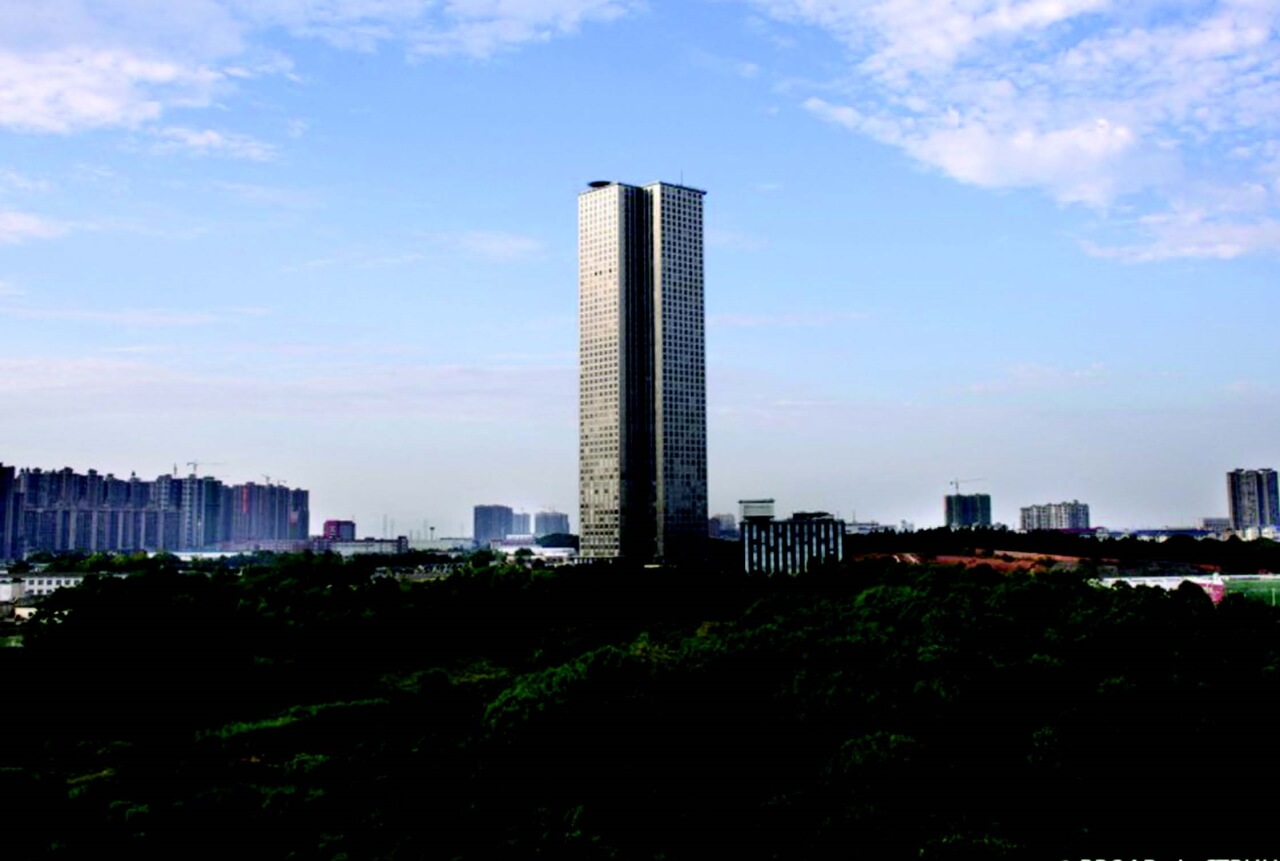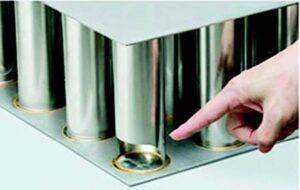
The Chinese company BROAD Group has developed a revolutionary modular construction style that has enabled it to perfect eco-friendly, prefabricated stainless buildings it says will “last forever”. And they are building them at a rate of three storeys per day. It’s the dawn of a new era in stainless modular buildings.
Text & images by the Broad Group
The origins and emphasis of the Chinese BROAD Group were in manufacturing (non-electric) air conditioning systems for commercial buildings such as the Dubai Mall or civil infrastructure facilities, such as Madrid Airport. Things might have stayed that way if it hadn’t been for a parallel preoccupation of the group’s chief executive and chairman, Zhang Yue. He had grown increasingly frustrated with the building industry –not only with its often suboptimal quality standards but also the prevalent disregard for environmental protection.
Backed by his manufacturing experience, Zhang Yue resolved to revolutionise the construction of buildings by applying manufacturing industry processes and principles: factory-made components, quality management strategies, and energy-efficient techniques. In 2009, he founded BROAD Sustainable Building Co. Ltd (BSB), specialising in the prefabrication and assembly of high-rise buildings.
Since its foundation, BSB has completed more than 30 pilot and commercial projects, mainly in China. The most celebrated of these pioneering projects is Mini Sky City (J57), a 57-storey building erected in just 19 days. Construction was captured in a time-lapse video that made international headlines and received millions of clicks on YouTube. BSB also constructed the 30-storey T30 building in 15 days and the 15-storey Newark Hotel in just six days.
Prefabricated components

Prefabricating buildings off-site increases the speed and quality of construction. Central to the technology are two massive prefabricated components. The first is the standardised floor plate, a stainless steel frame structure measuring about 12.19 × 4.87 metres. Each giant plate is pre-fitted with pipes and wires, and flooring such as tiles or laminate. The second centrepiece is the load-bearing structural steel column.
The prefabricated columns are erected during assembly, and the floor plates are simply fitted into position, making the construction process “as easy as playing with Lego”. The role of the on-site workers is mainly to connect the steel columns, bolts and wall panels and to link up the pre-installed wiring and piping between the plates. The prefabricated exterior walls come complete with four-pane windows and integrated solar shading. On-site, the walls are lifted into position by cranes. 90% of the building is prefabricated in the factory, which maintains efficient production and enables rigorous quality control.
Stainless steel B-CORE slab
One weak point of steel structures generally is their susceptibility to loss of integrity due to fire and potential corrosion that will affect them during their lifetime. In response to this challenge, BSB developed the stainless-steel B-CORE slab, which improves stability, extends the building’s life and avoids rework due to corrosion. This slab form combines strength, thinness, high-temperature resistance, anti-corrosion and sound isolation – all at a lower weight and thus higher specific strength than standard steel components. What’s more, the slab structure completely avoids concrete.
Previously, this kind of steel structure was limited mainly to aerospace design as it was very costly to produce. However, BSB succeeded in dramatically lowering the cost by inventing automatic copper-brazing to streamline production. The company also uses the innovative steel for columns, crossbeams, floor slabs, walls and roofs. The stainless-steel slab component is produced in 12×2 m, 15cm thick panels which fold exactly to the size of a 40ft container for low-cost transportation – without the need for a container.

The impact
BSB’s technology proves how steel-frame prefabrication reduces the speed and cost of construction while increasing quality and energy efficiency. The prefabrication strategy has many advantages over traditional construction techniques.
Time: The 57-storey Mini Sky City building was completed in just 19 days, having risen each day by three storeys typically. By contrast, traditional high-rise building methods follow the 2-10-day cycle (for pouring concrete and allowing it to cure). Note that BSB’s avoidance of concrete, except in the foundations, reduces the building’s weight to a third or even a fifth of its traditional counterpart.
Cost: Shifting the bulk of work to the factory enables a massive boost in efficiency, thanks to scale effects and lean principles. On-site work is transformed; assembling the building involves little more than a series of short, straightforward, standardised tasks. Factory production reduces transport and logistics costs, as building materials can be stored and handled in large quantities off-site.
In combination, efficient manufacturing, assembly and logistics reduce the costs of a new building by 20%-40%.
Environmental impact: BSB buildings typically have thermally insulated 15cm-30cm thick walls, triple- or quadruple-glazed windows, fresh-air heat-recovery machines, external solar shading, and up-to-the-minute airconditioning and ventilation. The result is impressive: five times the energy efficiency of conventional Chinese buildings and 1% the level of air impurities–a particularly attractive combination for hospitals.
Furthermore, construction waste is less than 1% (as opposed to 5%- 10% for conventional buildings), and the buildings can be dismantled easily, offering the prospect of reuse and recycling of steel. Emissions during the construction process are virtually eliminated; negligible air and noise pollution are produced when the cranes lift the prefabricated modules to their final position.
Quality: The lightweight and ductile yet stiff steel structure enhances earthquake resistance and is certified to withstand magnitude 9.0 earthquakes.
Barriers to innovation and the solutions

Given its clear advantages, why is this style of prefabrication technology not more widespread? According to BSB, the main impediment seems to be scepticism from architects and designers, who are trained in classical construction methods and may associate prefabrication with low quality. Mistrust of prefabrication is not limited to architects and designers but extends to potential clients as well. BSB’s strategy in this regard is to publicise its processes conspicuously, and the now-famous internet videos are educating the market.
Another obstacle that BSB encounters is the lack of environmental awareness in China and other developing countries, where many project owners and developers are not focused on producing energy-efficient buildings. That said, the construction ecosystem in China is showing signs of change, with a growing concern for the sustainability and lifecycle performance of buildings. Part of the impetus is no doubt due to government commitments to reduce greenhouse gas emissions.
One other BROAD obstacle is worth mentioning is the system of third-party supervision that dominates the Chinese construction sector (and is a source of corruption within it). BSB has been challenging this system by setting quality standards and pressing for more certification; and by working with government institutes to promote their guidelines on prefabrication into regulations. Happily, things are changing. Although prefabrication accounts for less than 1% of construction today, the Chinese government aims to increase that share to 30% by 2026, with a special emphasis on steel structures. Hunan province, with BSB in support, is taking a leading role in this regard.
In a similar vein, BSB is seeking international expansion by getting its technology appreciated and accepted in other countries, and is working with international partners to acquire formal certification and building permission.
BSB is in the process of obtaining European CE certification and expects this process to be completed by May 2022.
Holon: 10 storeys in one day
Watch the video of the Holon being constructed in a single day: https://en.broad.com/ProductShow-111.aspx
57 storeys in 19 days
Watch how the 57 storey Mini Sky city was erected in just 19 days: https://www.youtube.com/watch?v=PyxwgLYbAk0

